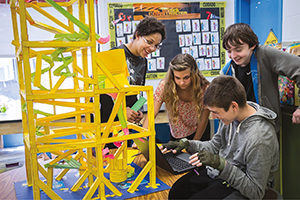Get support for student success - right in your inbox
NHLI | New Hampshire Learning Initiative
All Students Deserve a Quality Education
/ May 2, 2019
Assessing Performance in a Competency-Based System

As a teacher, I relied on my supportive colleagues to be a sounding board for ideas, but as the first curriculum director for the Sanborn Regional School District in Kingston, N.H., I was on my own as I faced the challenge of aligning K-12 curriculum and instruction in four schools.
When I found myself feeling isolated, my first order of business was to build a team. I reached out to teachers and administrators who could share decisions, guide the district and collaborate, demonstrating that a group could be far more effective than one curriculum director on her own.
The team worked well together and pushed forward many substantial changes in our district — improved curriculum, improved new opportunities for student growth, developed new systems for reviewing evidence of learning and improving assessment practices and strengthened solid collaborative practice. The curriculum changes gave the teachers the opportunity to play to their own strengths and, more importantly, to their students’ strengths.
To what do we owe our success? Our team listened to teachers. We listened to teacher observations about learners. We listened to teachers’ concerns about the intrusion of standardized testing. We listened as teachers shared their experiences in the classroom with individual students and classes. Then we took action.
We prioritized professional time for teachers to share their practices with other educators. We invited teachers to the table as we made decisions about learning. We collaborated to ensure the best decisions were being made to benefit both teachers and students. All of these choices positively affected learning in the classroom.
Transforming Assessment
When the New Hampshire Department of Education invited Sanborn Regional School District to be part of a project to develop an accountability strategy that would reduce the level of standardized testing and incorporate locally developed common performance measures, leadership and educators welcomed the chance to participate.
For four years, the project, the Performance Assessment for Competency Education initiative, or PACE, has been supporting educator and administrator professional collaboration in redesigning assessment and instruction to improve student learning beyond the local district level and broadening it to a state-level model.
In my role as the executive director of the New Hampshire Learning Initiative, I act as the curriculum director of the PACE project, which gives me an opportunity to continue my collaboration with other districts’ lead colleagues but also support the introduction of new districts and their administrators into the work. Each summer, the district leads share their work within the PACE project with administrators across New Hampshire and to other states at the summer PACE convening.
Multiple stakeholders, including state leaders, experts in assessment and accountability, and district and school leaders, work together to create a plan for the design, implementation and scaling of a reciprocal accountability system that ensures all students have opportunities to gain critical knowledge and skills. PACE includes:
» High-quality common performance tasks;
» Locally designed performance tasks with guidelines for ensuring high technical quality;
» Regional scoring sessions and local district peer review audits to ensure sound accountability systems and high inter-rater reliability;
» A web-based bank of local and common performance tasks; and
» A regional support network for districts and schools.
The PACE assessments are designed to support deeper learning through competency education and are closely integrated into students’ day-to-day work, which makes the assessments more meaningful. Students demonstrate their competency through multiple performance assessment measures in a variety of contexts.
The design of the PACE performance assessments focuses on embedding the assessments within local units of study and incorporates the curriculum at the district level. The tasks share common elements, including opportunities for student agency and strategies for engaging students through Universal Design for Learning and, yet, the tasks fit within the districts’ unique context.
The assessments also include collaboratively designed instructional plans, activities and resources. The assessments, which can be administered at any time during the school year, are implemented as part of the class and are used to inform student grading, which has the added benefit of supporting improved student engagement.
|
|

Collaborative Relationships
Teachers from several districts across the state participated in the PACE assessment design process from the beginning. They met to discuss, develop and agree on common assessments for English/language arts, math and science in grades 3-10 that could be implemented across districts, which is a challenging task. Yet as teachers took the lead and their voices were heard and validated by the team, they quickly bonded, developing a large network to support them when they headed back to their classrooms to implement the changes.
The PACE project provided teachers with a meaningful role in defining what accountability for learning could be if we started in the classroom and included evidence of learning from actual classroom activities and assessments. Sanborn teachers were willing to do the work to build this system, opening up their instructional practices and sharing their classroom assessments and grades for student competencies — a level of transparency that might have made other teachers uncomfortable.
It also required them to work collaboratively with educators from across the state to develop shared understandings of what it means for students to be competent in mathematics, English language arts and science. Educators’ work on defining these subject-area competencies and developing accompanying assessments showed their commitment to representing learners’ knowledge, understanding and skills in ways that generic standardized measures could not.
Teachers weren’t the only ones who developed close respectful relationships within and across school districts in New Hampshire. District and school administrators forged similar relationships through their engagement with the PACE work.
These collaborative relationships among administrators have played a significant role in improving learning for students and providing professional experiences for teachers. Working together across districts, the administrators shared practices, resources, strategies, professional development approaches and plans. This type of collaboration helped administrators new to their positions benefit from experienced administrators.
Layers of Support
To truly maximize their influence on student learning, teachers must be supported by school and district leaders who value their judgment and who support the myriad instructional pathways necessary to support learners.
As a district administrator, my role was to help teachers recognize the importance of shifting to a more personalized and competency-based learning system and to support them with the depth and quality of professional learning they needed to build and implement that system for students.
With the support of PACE Director Mariane Gfroerer, the N.H. Department of Education, under the leadership of the Commissioner Virginia Barry and Deputy Commissioner Paul Leather, eliminated barriers to the work, listened to district administrators and adopted state policies that supported competency education and responded to PACE administrators’ requests when developing the accountability measures required for the U.S. Department of Education.
One of the most complicated aspects of participating in the PACE project was meeting the data collection requirements, which required districts to reconceptualize their data systems. The first-cohort districts worked together to build a system to capture the required data. Barbara Munsey, superintendent from the Epping School District; Mary Moriarty, assistant superintendent from the Rochester School District; Kathy White, dean of instruction at Souhegan High School; and I, curriculum director for Sanborn, shared how we had designed our own district systems, then jointly built data protocols with shared common elements across our districts. We worked closely with experts to ground the work realistically at the district level.
As the project expanded, other district leaders contributed their expertise to improve our practice: Donna Palley, assistant superintendent from Concord; Christine Landwehrle, assistant superintendent from Amherst; Leah Holtz, principal at the Monroe Consolidated School District; and Kyle Repucci, assistant superintendent for Rochester.
Today the administrators for the PACE project, or PACE district leads, continue to add to the expertise of the group. Last October, the New Hampshire Department of Education received approval to continue PACE for the next five years. This approval will require the PACE leadership to design pathways for new districts to become a part of PACE and new systems to maintain the quality of the professional development provided. The PACE district leads will be a part of what the next few years look like for the project.
Beyond Accountability
The PACE project usually is described as an initiative about accountability, but at its core, it is about improving learning in the classroom and providing students with opportunities to demonstrate their competency. The PACE project helps teachers acquire a deep understanding of assessment and student learning. As teachers work on the assessments, they advance competency learning and learn to better support student agency and personalized learning.
The Center for Collaborative Education and the National Center for the Improvement of Educational Assessment provided key professional development to PACE educators and helped develop quality assessments embedded in classroom practice. The experts grew with the districts, listened to the concerns and challenges at the district and school level, and met the district leaders halfway.
These experts helped district leaders raise expectations for student work. In turn, district leaders helped the experts create a system that worked in authentic school settings. We worked collaboratively to capitalize on this opportunity and to support each other as our districts took on the challenge of redesigning the system to balance reciprocal accountability and classroom learning.
When I look back on the last four years, I’ve learned the conditions good leaders create for their teachers are the same conditions good teachers create for their students.
It all started with listening.
Originally published in AASA’s School Administrator, May 2019 at http://my.aasa.org/AASA/Resources/SAMag/2019/May19/Hume-Howard.aspx
Categories: Competency-Based Learning (CBL) NHLInsights, Research and Resources